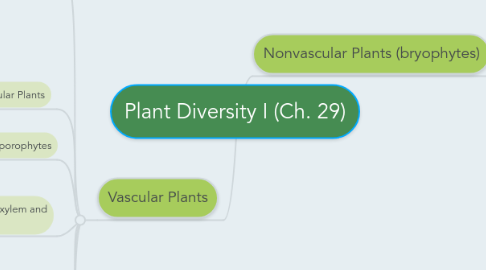
1. Vascular Plants
1.1. Seedless Vascular Plants
1.1.1. Sperm need a film of water to swim through to reach and fertilize the egg
1.1.2. Lycophyta: Club mosses, spike mosses, and quillworts
1.1.2.1. Giant lycophyte trees survived for millions of years in moist swamps
1.1.2.2. Surviving species are small herbaceous plants
1.1.3. Monilophyta: Ferns, horsetails, and whisk ferns & relatives
1.1.3.1. Ferns are the most widespread seedless vascular plants (>12,000 species)
1.1.3.2. Most diverse in the tropics, but many thrive in temperate forests and some adapted to arid habitats
1.2. (Seed) Vascular Plants
1.2.1. Gymnosperms
1.2.1.1. "Naked seed" plants, including the conifers
1.2.2. Angiosperms
1.2.2.1. Flowering plants
1.3. Life cycles with dominant sporophytes
1.4. Transport in vascular tissues called xylem and phloem
1.4.1. Xylem conducts water and minerals (incl. tracheids, tube-shaped cells). Cell walls strengthened by lignin
1.4.2. Phloem distributes sugars, amino acids, and other organic products
1.5. Well-developed roots and leaves, including spore-bearing leaves called sporophylls
1.6. Roots
1.6.1. Organs that absorb water and nutrients from the soil
1.6.2. Anchor vascular plants
1.6.3. May have evolved from subterranean stems
1.7. Leaves
1.7.1. Increase the surface area of the plant body to capture solar energy for photosynthesis
1.7.2. Microphylls: small, spine-shaped leaves with a single vein
1.7.3. Megaphylls: leaves with a highly branched vascular system
2. Nonvascular Plants (bryophytes)
2.1. Liverworts
2.2. Mosses
2.2.1. Particularly common and diverse in moist forests and wetlands, but capable of inhabiting diverse and sometimes extreme environments as well
2.2.2. Some might help retain nitrogen in the soil
2.2.3. Sphagnum, or "peat moss," forms extensive deposits of partially decayed organic material known as peat (fuel source and soil conditioner)
2.2.3.1. Peatlands contain 30% of world's soil carbon
2.2.3.2. Overharvesting of Sphagnum in peatlands could release stored CO2 to the atmosphere, contributing to global warming
2.3. Hornworts
2.4. Life cycle dominated by (haploid) gametophytes
2.5. Have small sporophyte dependent on the gametophyte
2.5.1. Typical sporophyte consists of a foot, seta (stalk), and a sporangium (a.k.a. capsule)
